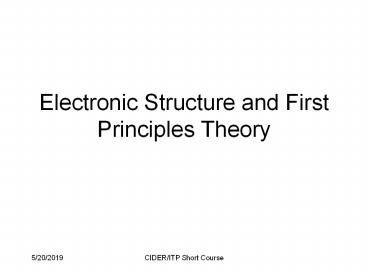Electronic Structure and First Principles Theory - PowerPoint PPT Presentation
Title: Electronic Structure and First Principles Theory
1
Electronic Structure and First Principles Theory
2
Equation of State
- Start from fundamental relation
- Helmholtz free energy
- FF(V,T,Ni)
- Isotherm, fixed composition
- FF(V)
- Taylor series expansion
- Expansion variable must be V or a function of V
- Faf2 bf3
- f f(V) Eulerian finite strain
3
Microscopic Picture 1Pair Potential
- Assume pairwise interactions
- Assume simple functional form
- V(r) exp(-r/?? Z1Z2e2/r
- Advantages
- Fast
- Fundamental inadequacies
- C12C44
- Empirical inadequacies
- N1th observation
- More complex functional forms and/or parameters
depend on - Pressure
- Temperature
- Structure
4
Microscopic Picture 2Gordon-Kim
- Assume charge density of crystal that of
overlapping, spherical, fully charged, ions - Assume charge density of ions that in free
state - Advantage
- Ab initio
- Problems
- Only ionic bonding
- Cauchy violations
- O2- not stable in free state
- Partial solution
- Breathing
5
Ions or electrons?
- Pauling/Goldschmidt Model
- Hard fully charge spheres
- Rationalize/predict low pressure structures
- High pressure?
- PbondeV/Å3160 GPaPmantle
- Ions change
- Size
- Shape
- Charge
6
The one electron atom
- Exactly soluble
- ?i wave function of state i
- ? can have either sign
- Charge density, ???? square of wave function
- Ei Energy of state i
- States described by three quantum numbers ( spin)
7
Multi-electron Atom in a crystal field
Multi-electron atom
3d3z2-r2
m2
One-electron atom
3dx2-y2
m1
3d
3dyz
m0
l0
l1
l2
3dxz
m-1
3s
3p
3d
3p
3dxy
n3
m-2
3s
2s
2p
n2
1s
n1
8
Molecules
- Isolated Atoms
- One energy level
- Molecule
- Two energy levels
- Bonding
- Anti-bonding
- Population
- Energy difference
- Temperature
9
Metallic Solid
- Asymptotically continuous band of N states
- Each state accommodates 2 electrons
- Half-filled band
- Fermi energy separates occupied from unoccupied
states - No gap
10
Covalent Solid
- Doubled unit cell
- Halved Brillouin zone
- Folding
- Gap
11
Ionic Solid
- Cation and Anion
- Lower energy state valence electrons on anion
- Flat bands localized states
- Gap
12
Density functional theory
- No assumption about charge density, type of
bonding, - No experimental input, i.e. no free parameters
- Positions and charges of nuclei.
- Assumption of nuclear positions is generally
relaxed - Not exact
Cohen, 1992
13
Uniform Charge Density
- Uniform distribution of atoms
- PRTnA
- Uniform distribution of electrons
- Kinetic
- Exchange
- Correlation
- Ion-electron interaction
Nuclei
Electrons
14
Uniform Charge Density
- EOS depends on Z
- Jupiter, Z1
- Mantle, Z10
- Core, Z26
- Calculated density too high
- Screening
15
Density Functional Theory
- Kohn,Sham,Hohenberg
- Ground State Internal Energy a unique functional
of the charge density - Approximations
- Essential
- Exchange-Correlation Functional
- Local density approximation
- Convenient
- Pseudopotential approximation
16
Computational Methods
- Pseudopotential
- Nuclear potential is hard!
- Replace with that of nucleus core electrons
- Represent valence electrons with plane wave basis
set
17
Origin of Magnetism
Bulk f(V)
electron s1/2
atomic or local S2
Ferromagnet
Paramagnet
Pauli Paramagnet
18
Magnetic CollapseOrigin
Levels
High Pressure
Low Pressure
Bands
19
Electronic transition in Potassium
Potassium
- Potassium shows a fundamental change in its
electronic structure at high pressure, from that
of an alkali metal to that of a transition metal. - 4s electrons are more strongly influenced by
compression than the initially unoccupied 3d
states, which are increasingly populated at high
pressure - Large decrease in ionic radius
- Change in chemical affinity from lithophile to
siderophile?
Bukowinski (1976) GRL 3, 491
20
Phase transition in CaSiO3 perovskite
- Prediction of behavior and properties at extreme
conditions - Origin of behavior and properties at the
fundamental level - Interplay with experiment
- Test of fundamental theories
- Guiding new experiments
- Interpretation of observations































